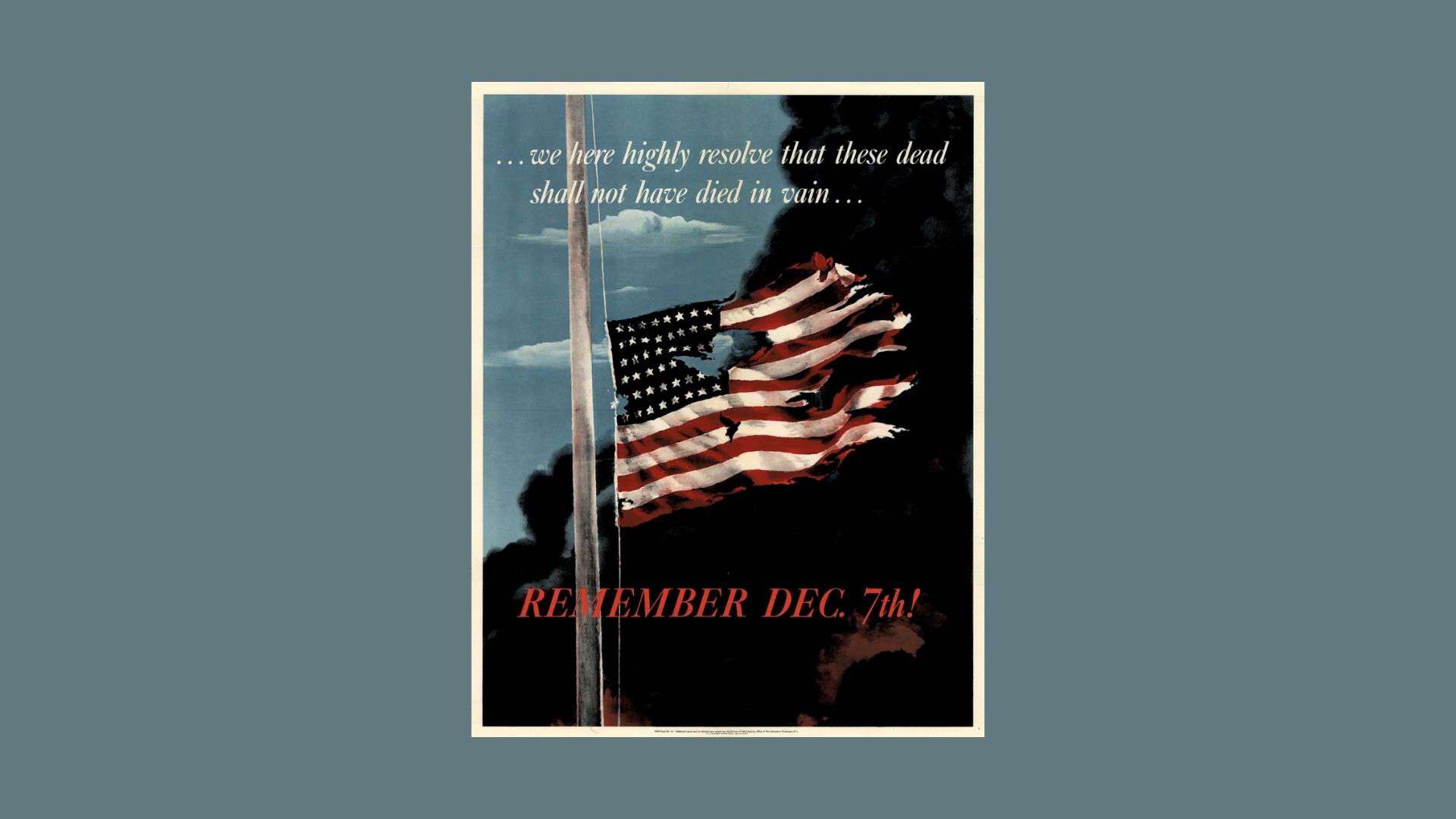No more let sins and sorrows grow
nor thorns infest the ground;
He comes to make his blessings flow
far as the curse is found,
far as the curse is found,
far as, far as the curse is found.
—Isaac Watts—
On the December 7, 2018 edition of BreakPoint, John Stonestreet, president of the Colson Center for Christian Worldview, declared, “Pearl Harbor was for the Greatest Generation what September 11 is for ours: a national memory.” Historian and author William Bennett writes, “An entire generation of Americans would remember where they were when they heard the shocking news of [the Japanese attack on] Pearl Harbor.”1
For a variety of reasons, ships in the American navy fleet stationed a Pearl Harbor were especially vulnerable that first Sunday morning in December, 1941.2
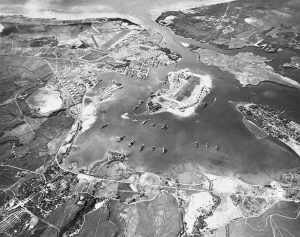
Historians Larry Schweikart and Michael Allen write,
Japan attacked methodically and with deadly efficiency. Bombers, torpedo planes, dive bombers—all covered by Mitsubishi Zero fighter planes—took out American air power, then hit the battleships on “battleship row,” sinking or severely damaging every one. The worst casualty, the USS Arizona, went down in ten minutes with a thousand sailors. Few ships of any sort escaped damage of some type.3
Eyewitness Testimony
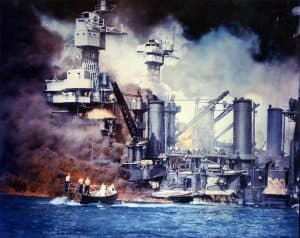
Seaman First Class Jim Downing was stationed at Pearl Harbor and was serving as the USS West Virginia‘s chief mail clerk on that fateful day, but he was not aboard the ship when the attacks began. Newly married, he and his wife Morena had an apartment in Honolulu. Of course, immediately after hearing what had happened, Jim sprung into action.
All I could think was that I had to get to my ship. Since the motor launches weren’t running, my friend Ken Watters and I, along with seven or eight other fellows, hurried on foot toward a ferry landing near the navy hospital. Once aboard the ferry for the short crossing to Ford Island and Battleship Row, I had a better view of the West Virginia. As many as nine torpedoes and a pair of unexploded, two-thousand-pound bombs that crashed onto the deck had done their work. In addition to smoke and fire, the most glaring damage was a 140-foot hole above the second deck on the port side.
The crew had counter-flooded on the starboard side to keep the ship from capsizing. She now rested on the bottom of the shallow harbor, part of her starboard side jamming the adjacent Tennessee against a quay wall.
Once on Ford Island, Ken Watters and I parted ways, he to the Maryland and I in the direction of the West Virginia. At the quay, I boarded the Tennessee and ran to the opposite railing. The deck of the West Virginia was more than ten feet away and five feet below me, listing at a six-degree angle. However, the barrel of one of the Tennessee’s five-inch guns at midship was extended across the water and just over the railing of the West Virginia. I climbed onto the barrel and slid down until I reached the deck of my ship.
I was aboard a nearly abandoned vessel. Our captain, Mervyn Bennion, had been mortally wounded during the first wave of the attack. Most of the crew that survived had evacuated, though a few remained. The main thrust of the fire had already moved from the bow to my position midship. Flames had engulfed the topside “ready lockers”—the airtight, watertight metal lockers that housed fifty rounds of ammunition for every gun. I immediately decided that these were my priority. If they blew, the secondary explosions would cause further damage.4
Jim used a water hose that had been pulled over from the nearby ship, the Tennessee, to douse the flames at the ready lockers. After putting one fire out, he directed the hose toward another; then flames at the first location appeared again. Jim continually changed targets as he attempted to apply the water where it was needed most.5
The attacks continued; a second wave followed the first. The danger was immediate. Many, many times throughout the morning, Downing, who’d become a Christian just a few years earlier, prayed, “Lord, I’ll see you in a minute.” Then later, “Lord, I’ll see you in another minute.” Yet God spared him. Remarkably, during that otherwise harrowing period he experienced God’s peace in a powerful and profound way.6
Notifying Families
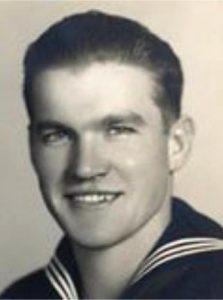
As chief mail clerk for the West Virginia, Jim knew the names and had access to the home addresses of everyone aboard. Inspecting dog tags, as he surveyed the damaged ship and the human carnage that it contained, he memorized names of the dead and later wrote notes to family members. He also visited those who had been hospitalized, asked them what they wanted to say to their families, and wrote notes to their family members as well. Not surprisingly, the events of December 7, 1941 remained vivid in Jim Downing’s mind for many decades thereafter.
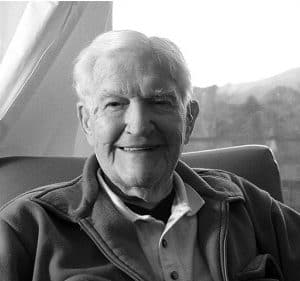
Downing’s career in the Navy would not end until 1956. His 24 years of Navy service included his leadership as captain of the USS Patapsco. Downing had a distinguished military career, but his ultimate priority was his commitment to Jesus Christ. In 1935 he’d become a Christian. Dawson Troutman (1906-1956), founder of a ministry called the Navigators, personally encouraged and discipled him. After retiring from the Navy, Jim worked full time in the ministry of the Navigators. He even held numerous speaking engagements after his official work with the Navigators had ended.
Jim died in 2018 at the age of 104. Shortly before his death, he wrote a book about his life, his conversion to Christ, and his experiences in the military and in ministry. His autobiography is titled The Other Side of Infamy: My Journey through Pearl Harbor and the World of War.
The Doolittle Raid
The leader of the Japanese raid on Pearl Harbor was Mitsuo Fuchida. At the time of the bombing, he was 39 years old. “[Y]ears later under much better circumstances,”7 Jim Downing would meet him personally. Fuchida’s remarkable journey also would lead him to meet and befriend someone else — an American airman who was imprisoned by the Japanese during most of World War 2. This man and other American POWs held by the Japanese were treated brutally. His name was Jacob “Jake” DeShazer. Jake was one of “Doolittle’s Raiders.”
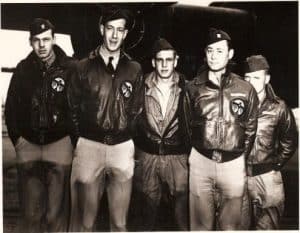
The United States entered World War 2 on December 8, 1941, following a passionate speech by President Franklin D. Roosevelt. On that same date, the US declared war on Japan. It would declare war on Germany three days afterward.
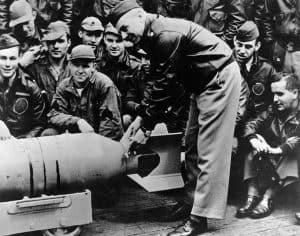
Following the Japanese attack on Pearl Harbor, the American naval fleet was down, but not out. President Roosevelt wanted to strike back against the Japanese as soon as possible; not just to retaliate, but also to send the clear message that the United States refuses to be pushed around. The American response, a direct bombing of Japan — was led by Lieutenant Colonel Jimmy Doolittle. The “Doolittle Raid” took place on April 18, 1942, not even six months after Pearl Harbor. A great deal of planning and preparation had to occur to make the raid happen because modifications of equipment and other innovations were necessary. Although the raid inflicted very little damage of any real consequence on Japan, the psychological effects it produced on both sides of the Pacific were enormous.
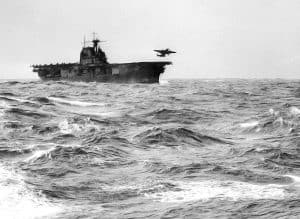
The operation involved 16 5-member crews in 16 B-25 Mitchell planes. The bombers would take off from the USS Hornet, an aircraft carrier in the Pacific. They would deliver their bombs to various targets in Japan, then fly to China, where arrangements had been made for crew member to return safely to the United States. However, not all of China was safe territory.
The USS Hornet was spotted early by a fishing boat. In order not to jeopardize the mission, the planes took off 200 or so miles away from the planned departure site. Would the raiders have enough fuel to complete their mission and land safely in China? They didn’t know. The crews delivered their “cargo,” began making their way to China, and hoped and prayed for the best.
Since the raid launched from farther away than initially planned, the planes were now low on fuel. One plane headed for Soviet territory and landed there. The crew was interned but treated well. In 1943, they “escaped” with help from the Russian NKVD secret police and made it back home.
The other 15 planes flew on to China. Several landing fields along the coast were equipped with radio transponders and held fuel for the planes. The U.S. Navy, however, did not signal the Chinese in time, so the transponders were left off, and the Doolittle Raiders could not find the fields. Running on fumes and with night approaching, the crews either bailed out or crash-landed one by one.
Three men died bailing out. The Japanese captured eight, executing three of them, and one died in captivity. [Four, including Jake DeShazer, remained as POWs in Japanese custody until the end of the war.] Everyone else, however, made it out safely. The Chinese received them warmly and helped them return to U.S. forces.
The Harrowing Experience of Being a POW Held by Japan
The name of the prisoner who died of starvation and malnutrition was Bob Meder. Initially, he was one of the POWs held by the Japanese, so after the executions, the number of Doolittle Raiders the Japanese held totaled five. Would they also be executed? They knew it was a real possibility, but at one point Jake DeShazer was informed that Japan’s Emperor Hirohito had commuted his death sentence to life imprisonment.
Even so, with rare exceptions, cruel treatment was the order of the day. Much of the time, the prisoners were held in solitary confinement. The brutality took its toll on everyone; yet the crewman who eventually died, Bob Meder, rarely complained.8
After Bob passed away, Jake reflected on statements Bob had shared with him. Several weeks before, when the guards had placed the two working next to each other weeding the prison courtyard, Bob had said to Jake,“You know, I do believe that Jesus Christ is the Lord and Coming King, and that He is God’s Son. God expects the nations and people everywhere to recognize Him as Lord and Savior, and the war is not going to stop until Jesus Christ causes it to stop.”9 Bob went on to tell Jake that even though it appeared world events were swirling out of control, he believed God still was in charge.10
Jake repeatedly mulled over everything Bob had said to him. He thought of his Christian upbringing. He thought of how, up until this point in his life, he basically had ignored God and the biblical teachings his parents and church had tried to impart to him. Now, Jake hungered to know more. Could Bob have been right? How could a good God allow such chaos and evil in the world? Yet Bob Meder had a perspective that Jake envied. Jake wanted to believe as Bob did, but he found himself in limbo, full of unanswered questions.11
A Bible — and the Answers Jake Sought
Not long after Bob’s death, the remaining prisoners noticed a softening in guards’ treatment of them. The food improved, and they even were given books to read. Among the five books the guards gave them was a copy of the Bible. Jake read everything available to him quickly and eagerly, but he had to wait his turn to read the book he most wanted to devour — the Bible. When at last it was in his possession, he had three weeks in which to read it, and he rarely put it down. He didn’t sleep but stayed awake reading. Even though the light in his cell was dim and the print in the book was tiny, he drank in its words as a thirsty man on a long hike would drink water after discovering a refreshing spring.12
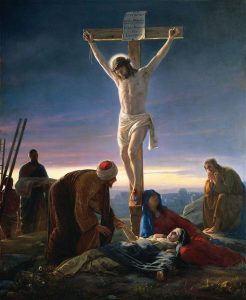
Jake soon saw how the Old and New Testaments were connected and how the overall message of the Bible came to a climax with the arrival of Jesus Christ and His ministry. Moreover, he was moved as he read of how Jesus suffered ridicule and abuse from Jews and Romans alike; yet despite being mistreated, as He was being executed on a Roman cross, Jesus asked God to forgive His tormentors.13
Forgive? How could anyone who’d been mistreated this way forgive? Jake had been consumed with hatred for his captors, but he now was beginning to realize his own hatred was putting him in yet another prison, one different and even more confining than the one that held him physically.
The more he read the Bible, the more Jake
became aware of a presence in the cell with him. That presence, he concluded, was God right there beside him, reaching out to someone who was lost, alone, and abandoned. The feeling overwhelmed Jake: someone really cared about him. Someone wanted to lift a burden from him, lead him to a new life, and offer a new way of thinking and living.14
Jake especially was drawn to Romans 10:9, which says, “[I]f you confess with your mouth the Lord Jesus and believe in your heart that God has raised Him from the dead, you will be saved.” He’d read this verse several times as he’d pored over the Bible, but now he had come to realize it was pointed directly at him, in a way he never could have imagined. He had to respond to what God had shown him in the Bible, and in particular to what God had revealed to him in this verse. Right then and there, on June 8, 1944, in his cell in China as a prisoner of the Japanese, Jake DeShazer prayed and asked God to forgive him of his sins. He told God he would confess with his mouth that Jesus was Lord, and that he had a heartfelt conviction God indeed had raised Jesus from the dead.15
If you confess with your mouth the Lord Jesus and believe in your heart that God has raised Him from the dead, you will be saved. For with the heart one believes unto righteousness, and with the mouth confession is made unto salvation.
—Romans 10:9-10—
As he prayed, Jake was overcome by a strange sensation. Despite the fact that he was a prisoner of war in solitary confinement in a brutal Japanese prison in China, his heart was filled with joy—joy like he had never felt before in his life. And at that moment he would not have traded places with anyone. He knew he had received God’s forgiveness. He was a new man. The horrors of prison life that surrounded him no longer had any sway in his mind. Nor did death. Death was merely something to be passed through on the way to eternity with Christ. Jake DeShazer was now God’s man. It might not have looked to the Japanese guards that much had changed on the outside. Jake looked to them to be the same bedraggled American airman who had helped bomb their homeland over two years before. But on the inside, everything had changed. Everything was new and alive to Jake.
During the remainder of his three weeks with the Bible, Jake managed to memorize many long passages of Scripture, which he would recite aloud to himself.16
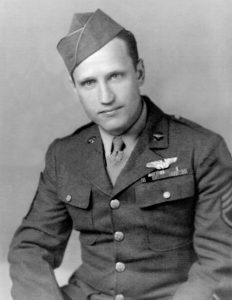
Not just immediately, but long-term as well, Jacob DeShazer’s life was transformed. After the war was over and he’d been released from the Japanese prison, he wanted his life to count for God. Over time, he began to see those who had mistreated him from a new and fresh perspective.17 They needed to know about Jesus. Jake had a growing sense that God wanted to use him to convey the good news about Jesus to the Japanese people.
Jacob married, and he and his wife Florence became missionaries to Japan, to tell the Japanese people about God’s love, about His Son Jesus, and about God’s offer of forgiveness and eternal life through Jesus. Early in his ministry to the Japanese, Jacob DeShazer wrote a tract titled “I Was a Prisoner of Japan.” You can read the tract here. It made its way into the hands of many, many Japanese people, including Mitsuo Fuchida.
An Invisible Hand — An Unseen Power
Other events were occurring in Fuchida’s life as well. Even though Fuchida was not tried for war crimes, he was made to testify during the trials of other Japanese military personnel. He resented this, because he believed the Americans were guilty of treating their captives as harshly as the Japanese had treated theirs. While Americans’ posture toward the Japanese people hadn’t been perfect and certainly wasn’t totally devoid of hatred, there still was a stark contrast between the way the two nations treated their POWs. This made an impression on Fuchida.
He also heard about a young woman named Peggy Covell. Peggy was in Japan, helping Japanese POWs reestablish themselves after the war. John Stonestreet reports that
Covell’s parents had been missionaries to Japan and were captured and killed by Japanese soldiers in 1943. Before the Japanese beheaded them, the Covells asked for 30 minutes in which to pray—in part, their daughter believed, for God to forgive those who were about to execute them.
Fuchida was astonished at the idea that anyone would forgive their enemies—or worship a God who would not, or could not, save their lives. Why, he wondered, would the Covells’s daughter return to Japan to help POWs?
The whole idea of abandoning vengeance and instead forgiving one’s enemies was a foreign idea to Fuchida. The Bushido code, or the Japanese concept of chivalry, demands vengeance. Forgiving one’s enemies as Jesus did, however, and as Jake DeShazer and Peggy Covell had done, wasn’t a sign of weakness, but strength.
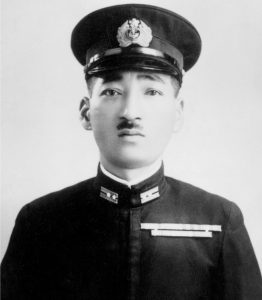
There’s something else. Mitsuo Fuchida’s life had been spared three separate times during the war. Jim Downing recounts each of these incidents in his book. [Emphasis has been added to enhance readability.]
The first incident was a crash landing on Borneo during the Battle of Java, which killed a crewmate. The second was during the Battle of Midway, when a bomb struck the carrier Akagi and blew Fuchida into the ocean. The Akagi sank and Fuchida’s ankles were broken, but he was rescued. The third incident was when we dropped the A-bomb on Hiroshima on August 6, 1945. Fuchida had been in the city since August 3 and had planned to stay until August 6, but he agreed to a last-minute request to assist another officer in another city and left the afternoon before. After the war, Fuchida retired to become a farmer. He was bitter and disillusioned about how the war and his life had turned out, but as the years passed, he began to wonder about his mysterious survival during the war.
Fuchida credited his survival to a great, unseen power.18
It was now 1950. As he pondered the events of his own life and Jacob DeShazer’s and Peggy Covell’s stories, he was overcome.
Fuchida bought a New Testament and began to read it. When he read of Jesus’ crucifixion and of His prayer that God would “forgive them, for they know not what they do,” Mitsuo Fuchida realized he was one of “them,” an individual who hadn’t realized what he had been doing for 47 years, and one who desperately needed divine forgiveness. He also understood that forgiveness could be his, but only through Jesus Christ. Fuchida wrote, “Now, I receive the only Son of God, Jesus Christ, as my Savior.”19
Not very long after Jake began his missionary work, Mitsuo Fuchida “became one of an estimated 30,000 Japanese citizens to embrace Christ under DeShazer’s influence. He published his story in From Pearl Harbor to Calvary.” You can learn more about the book here.
The Challenges and Rewards of Forgiveness
On several occasions in the years that followed, Jim Downing had opportunities to meet and to talk with Mitsuo Fuchida. Downing writes of the initial experience and of several others that followed. He also recorded some of his reflections.
Our turn came to greet Fuchida. [My wife] Morena put out her hand and shook his. “Isn’t it wonderful,” she said, “that although we were enemies, now we are brothers and sisters in Christ?” He nodded and smiled.
I was next. I couldn’t bring myself to do it, could not join in that warm welcome. I had seen too many friends die.
My right arm stayed at my side. I looked Fuchida in the eye and said, “I was on the West Virginia during the attack.”
“Yes,” he said, and nodded at me. “I remember that ship.”
In the group discussion that followed, I watched and listened closely to our visitor from Japan. I detected no pride in what he’d done during the war. He struck me instead as humble and genuinely repentant. A few years later, he overnighted several times at Glen Eyrie, the Navigator headquarters, on his travels through Colorado Springs. I greeted him there multiple times. Since his English was poor and I did not speak Japanese, I never tried to engage him in deep conversation. When I read some of his writings, though, I felt even more convinced that his spiritual conversion was real. He was sorry for his previous actions. Like so many, he’d been led astray by others in authority.
Jesus forgave his killers, and he calls upon Christians to forgive those who wrong us. For my part, I can say now that in my heart I have forgiven Mitsuo Fuchida for his role in the Pearl Harbor attack. I cannot yet say the same about the Japanese leaders who stirred up so much ambition and hate. I am not a perfect Christian. After eighty-plus years in the faith, I’m still working on it.20
All Christians struggle as they seek to live as Christ lived. Yes, God gives supernatural strength enabling believers to act in pure and righteous ways, as Christ did. Yet it remains a process. Realizing that Jim Downing was at Pearl Harbor on December 7, 1`941, we can appreciate his struggle.
That said, we also must realize that the Japanese leaders Downing admits he’s reluctant to forgive have not asked forgiveness, as essentially did Mitsuo Fuchida, who came to Christ in sincerity and humility. Further, we also need to note that although Downing admits he struggles, it’s clear he is open to God’s supernatural power in his life. It’s apparent he does not harbor resentment or bitterness in his heart, but has moved on.
Brothers in Christ
An important video originally shot in 1975 is now available on You Tube. From it, I have lifted audio clips of Jake Deshazer’s and Mitsuo Fuchida’s testimonies. Let their words inspire you and encourage you. Further, if you don’t yet know Christ as your Savior, let their these men’s true stories and the bond they share in Christ bring you to a point of placing your own faith in Jesus Christ for salvation and eternal life.
If you don’t yet know Christ as your Savior, let their these men’s true stories and the bond they share in Christ bring you to a point of placing your own faith in Jesus Christ for salvation and eternal life.
In the first clip, you’ll hear the testimony of Jacob DeShazer.
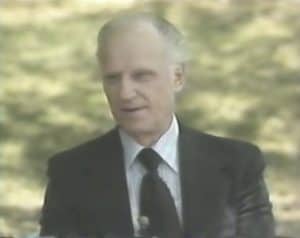
You’ll hear the testimony of Mitsuo Fuchida in this second clip.
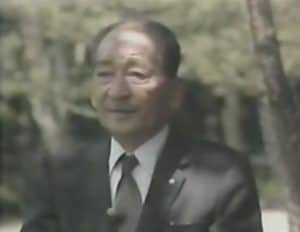
From Pearl Harbor Day, I spent myself as a most patriotic soldier for my mother country, but four years later, Japan lost the war. I came back to Nara Prefecture and took up farming. At that time, it was most miserable days for me.…
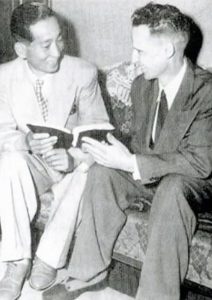
However, one day, General MacArthur, the supreme commanding officer of the occupied forces [called me to testify at war trials]. I went up to Tokyo, and I got off my train at the Seibu Railroad Station. And I went out to the front of the station. I saw there an American was handing out leaflet.…to the passersby. When I passed by him, he gave me one. I saw this pamphlet that was the story of DeShazer’s tract.…and there was a startling title, “I was a War-Prisoner of Japan.” …This I read over, and this inspired me.…to get a Bible. I never read the Bible.
At that time I was 47 years old, and during my 47 years I had never heard the name off Jesus. I was very lost but his story inspired me to get a Bible. And I bought a copy of Bible and I too read through the pages so eagerly every day. One day I was reading the Bible I came to the Gospel of Luke 23:34. Jesus was hanging on the cross, nailed to the cross, and He prayed, “Father forgive them for they know not what they do.”
Right at that moment, He came into my heart. I clearly understood what Jesus had done of the cross, He died for me too! Right away, I accepted Him my personal Savior.…Then He transformed me. I was a sinner. But He cleansed me. I accepted Him as my personal Savior. Since then I dedicated the balance of my life to serve Him, to serve Him.
This is my story. How this typical Japanese military officer became a preacher. It is no secret what God can do.
Copyright © 2021 by B. Nathaniel Sullivan. All rights reserved.
Unless otherwise indicated, Scripture has been taken from the New King James Version®. Copyright © 1982 by Thomas Nelson, Inc. Used by permission. All rights reserved.
Learn more about the DeShazers’ ministry in Japan and beyond by visiting www.jacobdeshazer.com.
Notes:
1William J. Bennett, America, The Last Best Hope—Volume II: From a World at War to the Triumph of Freedom, (Nashville: Thomas Nelson, 2007), 190-191.
2Larry Schweikart and Michael Allen, A Patriot’s History of the United States: From Columbus’s Great Discovery to the War on Terror, (New York: Sentinel, 2004), 594.
3Ibid.
4Downing, Jim. The Other Side of Infamy: My Journey through Pearl Harbor and the World of War (pp. 81-82). The Navigators. Kindle Edition.
5Downing, Jim., pp. 82-83.
6Downing, Jim., pp. 83-84.
7Downing, Jim., p. 75.
8Benge, Janet; Benge, Geoff. Jacob DeShazer: Forgive Your Enemies (Christian Heroes: Then & Now) . YWAM Publishing. Kindle Edition.
8Benge, Janet; Benge, Geoff.
9Benge, Janet; Benge, Geoff.
10Benge, Janet; Benge, Geoff.
11Benge, Janet; Benge, Geoff.
12Benge, Janet; Benge, Geoff
13Benge, Janet; Benge, Geoff
14Benge, Janet; Benge, Geoff
15Benge, Janet; Benge, Geoff
16Benge, Janet; Benge, Geoff
17Downing, Jim., p. 158-159.
18Downing, Jim., p. 158.
19Downing, Jim., p. 158.
20Downing, Jim., pp. 159-160.
